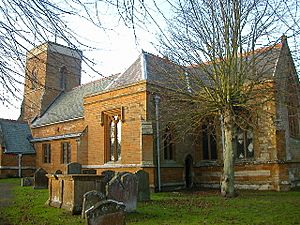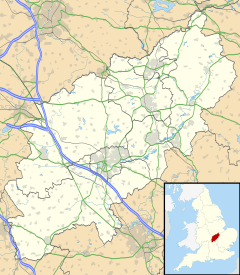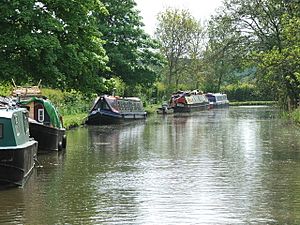Nether Heyford facts for kids
Quick facts for kids Nether Heyford |
|
|---|---|
 Church of St Peter and St Paul, Nether Heyford |
|
| Population | 1,637 (2011) |
| OS grid reference | SP659587 |
| Civil parish |
|
| Unitary authority |
|
| Ceremonial county | |
| Region | |
| Country | England |
| Sovereign state | United Kingdom |
| Post town | NORTHAMPTON |
| Postcode district | NN7 |
| Dialling code | 01327 |
| Police | Northamptonshire |
| Fire | Northamptonshire |
| Ambulance | East Midlands |
| EU Parliament | East Midlands |
| UK Parliament |
|
Nether Heyford is a village and civil parish in West Northamptonshire, England. It is located near the M1 motorway and the A5 and A45 roads. The village is about 6 miles (10 km) west of Northampton and 70 miles (110 km) northwest of London. A smaller village called Upper Heyford is just half a mile north.
The name Nether Heyford comes from 'Hay ford' or 'hedge ford'. This means a place where you could cross a river (a ford) that was near a hedge or an enclosure. In 1086, the village was recorded as "Heiforde" in the Domesday Book. The village is on the flat land near the River Nene. It used to flood often, which is why a lane there is called Watery Lane.
Contents
- Village Life and Facilities
- How the Village is Run
- A Look Back: Nether Heyford's History
- Village Newspaper
- Famous People from Nether Heyford
- Important Buildings in the Village
- The War Memorial
- Roman Villas in the Area
- Industrial History of Nether Heyford
- Getting Around: Transport
- Images for kids
- See also
Village Life and Facilities
Nether Heyford has one of the largest village greens in the country. It also has two pubs, two churches (one Anglican and one Baptist), and a youth club. You can find a park, a village hall, a hairdresser, a butcher, and a shop here.
The village has great sports facilities. There are extensive playing fields with a cricket club (Heyford CC) and a football club (Heyford Athletic). You can also find tennis courts and a bowls club. The Grand Union Canal also flows through the village.
How the Village is Run
The village has its own parish council. This council has 11 members who are chosen every four years by local elections.
A Look Back: Nether Heyford's History
Ancient Times: The Roman Period
People lived in this area during the Roman period. Two Roman sites have been found near the village. In 1699, a Roman floor made of mosaic tiles was discovered in Harestone Meadow.
Early English History: 900s to 1000s
In the 800s, the Danes attacked England's east coast. In 878, Alfred the Great, the Saxon King, made a deal called the Treaty of Wedmore. This allowed the Danes to settle in parts of England. Heyford was right on the border between Saxon and Danish lands.
In 1066, William of Normandy became King of England. This was after the Norman Conquest. The town of Northampton became very important during this time. The Domesday Book of 1086 recorded that 'Heiford' had about 500 acres of farmland. It also had a mill, 11 villagers, three smallholders, and four slaves.
Medieval Times: 1100s to 1400s
Not much is known about Heyford in the 1100s. However, in the 1200s, the local church was built. The first Rector (church leader) was Ralph in 1216. This was also when 'ridge and furrow' farming was very common. You can still see examples of these old farming patterns around the village.
The 1300s brought tough times. There were crop failures and serious diseases like the Black Death in 1349. About a third of the population died. This meant that some powerful landowners took control of larger areas. Sheep farming also grew, and many old fields were turned into pastures. This is why many 'ridge and furrow' patterns still exist today.
In the 1400s, the Mauntell family lived in Heyford Manor. Sir Walter Mauntell died in 1467 during the Wars of the Roses. He was buried in Heyford Church, and his tomb is still there. John Stanbridge was born in Nether Heyford in the late 1400s. He was one of the first people to create a printed English grammar book.
Tudor and Stuart Eras: 1500s to 1600s
The 1500s were the time of Tudor kings and queens like Henry VIII and Elizabeth I. The Mauntell family continued to own Heyford Manor. However, they faced challenges and lost their estates to the Crown due to legal troubles. The manor then passed to the Morgan family. Francis Morgan and his wife Anne are buried in Heyford Church. Their tomb has statues of them both.
In the 1600s, Heyford Parish Church got three of its four bells. The first two were added in 1601. The Manor estates changed hands several times. The original Manor House building became empty and fell into disrepair.
In 1674, William Bliss, who grew up in Heyford but became a wine merchant in London, left money in his will for the village. He gave £400 to buy a schoolhouse and pay for a school master. The school was free for all children in the Heyfords. It opened in 1683.
The 1700s: Changes and Growth
The 1700s saw some religious changes. Different church groups, like the Quakers and Baptists, became more common. The current Manor House building, near the Church, was likely built around 1740. It used stone from the old house at Upper Heyford.
In 1750, the large open fields around Heyford were divided into smaller, enclosed fields. In 1793, work began on the Grand Junction Canal, which later became the Grand Union Canal.
The 1800s: Industrial Development
The 1800s brought big changes to Heyford. The population grew from 264 in 1801 to 750 by 1891. The canal, opened in the late 1790s, helped transport coal, lime, and bricks. The railway was built in the 1830s. These developments led to ironworks and brickworks being built. The Furnace Lane area became a major place for villagers to work.
The mill by the river was run by the Cosford family for many years. The current mill building was built in 1821. Religious groups continued to grow. The Baptists built their Chapel in 1826, and the Methodists built theirs in 1838.
In 1870, a new law required all children to have a basic education. So, a new school building was opened on January 5, 1880. It had separate areas for infants, girls, and boys. Boys and girls were not allowed to mix, and there was a tall wall between their playgrounds.
The 1900s: Modern Times
The early 1900s saw the village's authority shift from the Church and Manor House to the Parish Council. The Parish Council's first official minutes appeared in 1901. Sports also became popular, with the cricket club founded in the early 1900s and the Heyford Athletic Football Club formed around 1908.
The First World War (1914-1918) had a big impact. Many young men from the village went to fight. By 1918, twenty-three young men from Heyford had died. Women began working in Northampton, some in a munitions factory.
After the war, village life was rebuilt. In 1921, the war memorial was unveiled. A public telephone was installed in 1922, and gas street lighting in 1924. The Baptist Chapel School Room was also built.
In the 1930s, the Heyford WI (Women's Institute) was formed. The village celebrated national events, like the silver jubilee of King George V in 1935. In 1939, the canal burst its banks, causing flooding in the Church Street area. Evacuee children also began to arrive due to the outbreak of World War II.
During the early 1940s, the brickworks closed. Heyford had its own 'Dad's Army' (Home Guard) to help protect the village during the war. After the war, two new church bells were added, increasing the total to six.
In the 1950s, important changes happened. In 1951, a rail crash occurred near the village, and villagers helped the injured. Mains water and sewage were connected to the village in 1952. The Heyford Scout Troop was formed in 1952, and the Cub pack in 1955. Work began on building the Village Hall in 1958. The M1 motorway was also built during the late 1950s, opening in 1959.
The 1960s brought major changes. Many new houses were built, and the population doubled. The old Methodist Chapel closed in 1963. Factory units were built on the old brickworks site. The Village Hall was officially opened in 1960 by the Earl Spencer. It was built by village volunteers. New social groups like the Gun Club and Youth Club were formed.
By the early 1970s, Heyford had grown into a modern village. In 1978, the Cricket Club was reformed. The village newspaper, The Prattler, also started publishing.
The 1980s saw improvements to the village. The Old Sun pub got a restaurant in 1985. The Playing Field and a Patisserie opened in 1986. A new Youth Club building was built in 1987. In 1981, Nether Heyford won the tidy village competition.
In the 1990s, new activities started. A Fishery opened in 1990. The Heyford Players, a drama group, was formed in 1991, and a bowls club also started that year. The Village Hall was extended, and a traffic calming scheme was put in place.
Village Newspaper
The village has its own newspaper called The Prattler. It is published every month and delivered to every house in the village.
Famous People from Nether Heyford
- Simon Thomas - A former presenter of the TV show Blue Peter.
- Anil Kumble - A famous Indian cricket player who lived in the village while playing for Northamptonshire CCC.
- Andy Faulkner - An actor and voice artist in New Zealand, who grew up in the village.
Important Buildings in the Village
The Church of St Peter and St Paul
The local church is dedicated to St Peter and St Paul. Parts of the church date back to the 13th century. Inside, you can find monuments to Sir Walter Mauntell (who died in 1467) and Sir Richard Morgan (who died in 1556).
Bliss Charity Primary School
The Bliss Charity Primary School has about 148 students. It was founded thanks to money left in the will of William Bliss. He was a wine merchant who died in 1674. William Bliss was born in Nether Heyford. He left £400 to the village to buy a schoolhouse and pay for a teacher.
The Old Rectory
The building that used to be the rectory (where the Rector lived) is in the Gothic style and was built around 1870.
The Manor House
The Manor House building dates back to the early 18th century.
Nether Heyford Baptist Church
In 1799, a small group of people in Heyford started meeting regularly for worship. A special building for their chapel was built in 1826. Before this, people from Heyford would go to Baptist chapels in nearby Bugbrooke or Northampton.
The Baptist Chapel grew, and by 1839, it had 76 adult members and 24 children. A Sunday school was started for the children. In 1922, a new Schoolroom was built for the chapel. In 1963, the Methodist Chapel in the village closed, and its members joined the Baptist Chapel. Some stained glass windows and pews from the Methodist Chapel were moved to the Baptist Church.
The War Memorial
In the center of the village, on its own small green, stands the War Memorial cross. It honors those who served and died in wars.
Roman Villas in the Area
The area around Nether Heyford has two Roman villa sites. One is at Whitehall Farm, near the A5 road. This road follows the old Roman Road known as Watling Street. In 2009, eight 1,400-year-old skeletons were found in a burial ground at this site. They might have been German soldiers hired to protect properties.
Another Roman site is east of the village in Horestone meadow. It was found in 1699 and had a beautiful colored floor mosaic. The mosaic was later removed in 1780. This area is rich in Romano-British history, with another villa site and museum at Piddington.
Industrial History of Nether Heyford
In the mid-1800s, Nether Heyford became a place of industry.
- Ironworks: A small ironworks called Heyford Ironworks was set up by 1857. It used iron ore from nearby areas. Another ironworks, Stowe Ironworks, opened in 1866. It produced iron and later steel. These works were connected by tramways that used horses and steam engines.
- Lime Kilns: Lime kilns, which made lime, also operated at the Stowe Ironworks site until 1900.
- Brickworks: In 1920, a brick company bought the Stowe Ironworks site. They made bricks there until 1940, using clay from a nearby pit. Today, this site is a small industrial estate.
Getting Around: Transport
Bus services in Nether Heyford are provided by Stagecoach Midlands and Uno. The closest train station is in Northampton.
The West Coast Main Line railway passes near the village. The nearest station used to be Weedon, but it closed in 1958. The railway line goes through the Stowe Hill tunnel under the A5 road.
Images for kids
See also
 In Spanish: Nether Heyford para niños
In Spanish: Nether Heyford para niños




